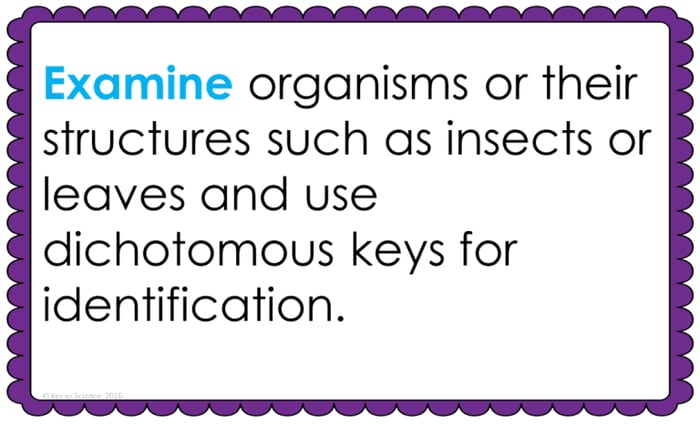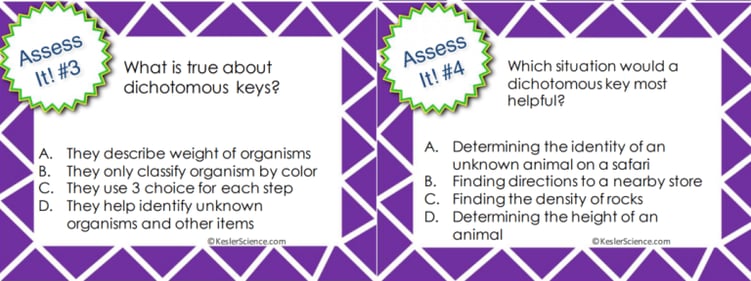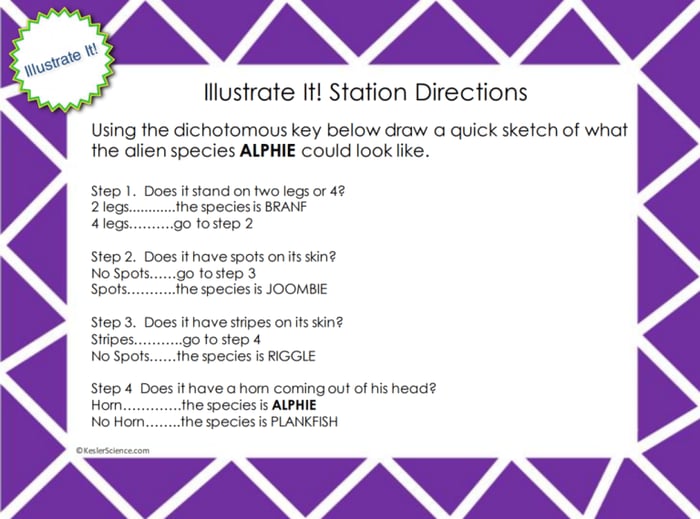
The teacher will help to clear any misconceptions about dichotomous keys. A major misconception is that students are probably not aware that "keys" for different organisms are already developed. They are a tool for identification.
Estimated Class Time for the Engagement: 20-30 minutes
EXPLORATION
This student-centered station lab is set up so students can begin to explore dichotomous keys. Four of the stations are considered input stations where students are learning new information about dichotomous keys and four of the stations are output stations where students will be demonstrating their mastery of the input stations. Each of the stations is differentiated to challenge students using a different learning style. You can read more about how I set up the station labs here.
EXPLORE IT!
Students will be working in pairs to better understand the dichotomous keys. Students will be using a dichotomous key to determine the flavor of a Jelly Belly that the instructor selects randomly from a bag. Students will follow the steps and record their observations on their lab sheet.
WATCH IT!
At this station, students will be watching a short video explaining how to use a dichotomous key. Students will then answer some questions relating to the video and record their answers on their lab station sheet. For example: What does the prefix "di" mean in dichotomous? What is the name of the organism #5 from the video? What is the name of organism #9 from the video?
RESEARCH IT!
The research station will allow students to explore an interactive web page that allows the students to use a dichotomous to identify a number of freshwater fish. Students will be instructed to complete a few tasks and record answers on their lab sheets.
READ IT!
This station will provide students with a one page reading about dichotomous keys. Students will get learn about couplets, how to use them, and what types of individuals use them and how it helps them. There are 4 follow-up questions that the students will answer to show reading comprehension of the subject.
ASSESS IT!
The assess it station is where students will go to prove mastery over the concepts they learned in the lab. The questions are set up in a standardized format with multiple choice answers. Some questions will ask students: What is the difference in appearance between a lemon and sour lemon Jelly Belly? How many questions need to be answered to identify a Very Cherry? What is true about dichotomous keys? Which situation would a dichotomous key be most helpful?

WRITE IT!
Students who can answer open-ended questions about the lab truly understand the concepts that are being taught. At this station, the students will be answering three task cards: Explain how to use a dichotomous key. Why would it be important for a commercial fisherman to have a dichotomous key on the boat with them? Why is it important for scientists to share their dichotomous keys with each other?
ILLUSTRATE IT!
Your visual students will love this station. Students are given the name of an imaginary organism and using a dichotomous key, following the key backward, and will draw the characteristics that lead users to that organism.

ORGANIZE IT!
The organize it station allows your students to identify the names of four different leaves while using a dichotomous key. Once students have completed their organization, the teacher will come and check their understanding.
Estimated Class Time for the Exploration: 1-2, 45 minute class periods
EXPLANATION
The explanation activities will become much more engaging for the class once they have completed the exploration station lab. During the explanation piece, the teacher will be clearing up any misconceptions about dichotomous keys with an interactive PowerPoint, anchor charts, and notes. The dichotomous keys lesson includes a PowerPoint with activities scattered throughout to keep the students engaged.
The students will also be interacting with their journals while taking notes from the PowerPoint. If you have students that need modified notes, the 5E lessons come equipped to help give every student access to the lesson.
Estimated Class Time for the Exploration: 2-3, 45 minute class periods
ELABORATION
The elaboration section of the 5E method of instruction is intended to give students choice on how they can prove mastery of the concept. When students are given choice the ‘buy-in’ is much greater than when the teacher tells them the project they will have to create. The elaboration project will allow students to create a dichotomous key using common items found in their home or outside.Estimated Class Time for the Elaboration: 2-3, 45 minute class periods (can also be used as an at-home project)
EVALUATION
The final piece of the 5E model is to evaluate student comprehension. Included in every 5E lesson is a homework assignment, assessment, and modified assessment. Research has shown that homework needs to be meaningful and applicable to real-world activities in order to be effective. When possible, I like to give open-ended assessments to truly gauge the student’s comprehension.
Estimated Class Time for the Elaboration: 1, 45 minute class period
DOWNLOAD THE FULL LESSON NOW
The full lesson is available for download from the Kesler Science Store. Save yourself a ton of time and grab it now.





